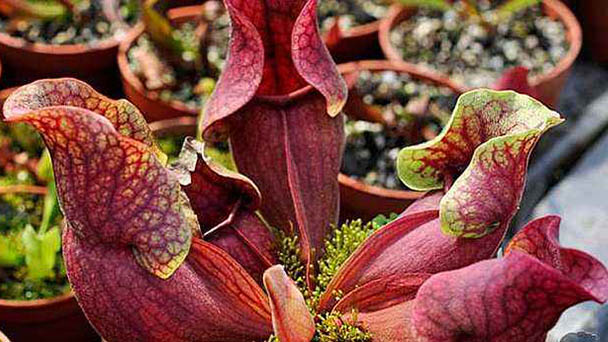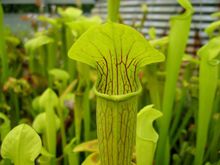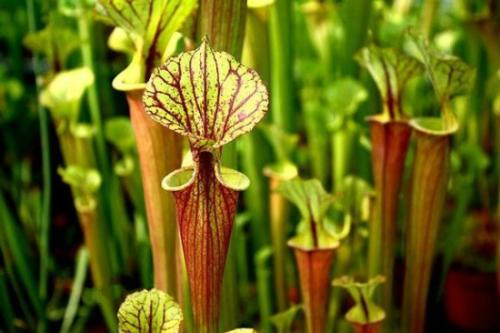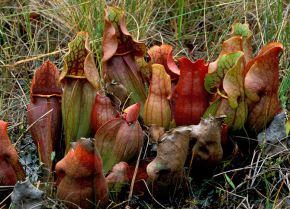Sarracenia profile
Written by Maggie
Nov 25 2020

Sarracenia has 9 species and numerous subspecies, varieties and artificially bred varieties. The leaves of Sarracenia are very strange and interesting. Some are tubular, some are trumpet-shaped, and some are kettle-shaped. Please see the details below.
Sarracenia picture

Distribution of origin of Sarracenia:
Sarracenia is a carnivorous plant native to the East Coast of the United States, Texas, the Great Lakes, and southern Canada. Most species are found only in the southeastern United States (only Sarracenia purpurea occurs in cooler areas).
Sarracenia's growth habits:
In common carnivorous plants, Sarracenia usually lives in moist places where nitrate-dominated nutrients continue to be washed away or become unusable due to the low pH of the soil. Sarracenia, on the other hand, has a competitive advantage over other plants because it attracts prey.
Sarracenia is a perennial herb that produces bottle-shaped leaves from the rosette of its underground stem. The leaves are divided into those that serve as a tonic and those that do not. The opening of the leaf is upward and facing the center, and it is in the shape of a vertical tube (there are also bottles and trumpet-shaped), and a lid extends from the entrance above the bottle. There is usually a "lip" around the mouth of the bottle, which can secret honey and smell. The lid itself also produces honey, but in a small amount.
Morphological characteristics of Sarracenia:
Whichever Sarracenia species, its bottles of the pipe can be divided into three to five areas: the first part the cap and the second section is the lips and mouth, three, four areas (some of the species are together) and the fifth district (only the Sarracenia purpurea has 5 area) is the main body of the bottle, these areas have specific functions, meet their morphology characteristics.
Most of the flowers in Sarracenia are scented, and these fragrances vary, but they are usually strong, even pungent. Sarracenia flava, in particular, has a strong smell that smells a bit like cat urine.

Growth cycle of Sarracenia:
Sarracenia begins to grow at the end of its flowering stage and continues into late autumn. In late autumn, Sarracenia begins to wither and the plant develops sword-shaped leaves (or leaflike stalks) that do not serve as pests. With fewer insects in the winter, the weather gets colder, reducing plant metabolism and other functions. At this point, it is not cost-effective to spend energy on long huge leaves. Sword shaped leaves are a relatively economical choice.
Principle of Sarracenia predation:
Sarracenia's leaves evolve funnel traps that produce enzymes to break down prey that fall into them. (The highly active Sarracenia and Darlingtonia californica don't have much fluid inside; Pygmy and sunbottle grasses fill the bottle with rain, but don't have as much digestive juice as pitcher plants; The way insects are broken down will be discussed later).
Insects are attracted by the scent secreted by the close gland of the bottle mouth and cap, and the back of the bottle is illuminated with the light like stained glass, which may also induce insects to go there. The smooth mouth of the bottle makes it easy for insects to fall into the bottle, and the dead insects are broken down and become nutrients for Sarracenia. Not all Sarracenia bottles have water in them, only Sarracenia purpurea deliberately makes them contain rain water. In fact, other types of caps keep rain out of the bottle, preventing flying prey from escaping.

Latest Updated
- Benefits of Bugleweed - 7 Science-backed Health Benefits
- Bugleweed Dangers & Side Effects - Is It Poisonous?
- How to Plant Evergreen Trees - What You Should Know
- When to Plant Evergreens - Grow Guide for Evergreen Trees
- 12 Wonderful Evergreen Shrubs for Your Garden
- 12 Popular Evergreen Plants with Pictures for Beginners
- When And How To Prune A Lilac Bush Like a Pro
- How to Grow & Care for Lilac Vine (Hardenbergia Violacea)
- Japanese Lilac Tree (Syringa Reticulata) Care & Propagation Guide
- Shumard Oak Pros and Cons - What to Know
Popular Articles
- Winter maintenance of Antirrhinum Majus
- How to Grow Terminalia Mantaly Tree
- How to Grow and Care for Crossostephium Chinense
- How to grow Antirrhinum Majus in spring
- Peristeria Elata (Dove Orchid) Profile: Info & Care Guide
- Underwatered Snake Plant (Sansevieria Trifasciata) - Signs And How To Fix
- How to Care for Brazilian Jasmine Plant (Mandevilla Sanderi)
- How to Grow & Care for Graptopetalum Purple Delight in Summer
- Rosa Chinensis (China Rose): Plant Growing & Care Tips
- How to Care for Baby Sun Rose (Aptenia Cordifolia)